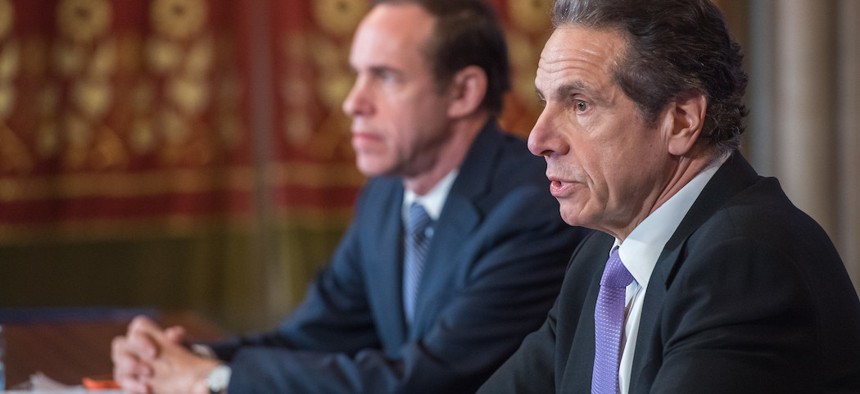Gov. Andrew Cuomo “has emerged as the executive best suited for the coronavirus crisis,” wrote the New York Times’ Ben Smith, sharing a sentiment that has hardened among close watchers of New York politics. Meanwhile, New York City Mayor Bill de Blasio “wrestles haltingly with a crucial decision and then heads to the gym” wrote Smith, and President Donald Trump displays his usual disastrous incompetence, at first downplaying the threat of COVID-19 and eventually responding only in haphazard fashion.
Cuomo has always been a commanding, near-authoritarian presence in New York, so now is his moment, the logic goes. But his press conference swagger masks an unflattering truth: he has responded to the coronavirus epidemic less swiftly than some counterparts in other states. He shines only when contrasted to the tragically inept de Blasio and the callous, volatile Trump.
Cuomo’s poise belies what has been a muddled approach to informing the public of the unprecedented crisis before us. While he, unlike de Blasio and Trump, deserves credit for leading rather than lagging, that should be the minimum we expect from our elected officials. Instead of lowering our standards, we should give Cuomo a mixed grade at best. And if the national media were less New York-centric, they might find a more heroic governor in Ohio or Michigan.
Last week, while governors of several states less affected by coronavirus than New York were shutting down schools in their states to stem the oncoming tidal wave of cases, Cuomo was dithering, deferring to localities as recently as Saturday. By Sunday night, Cuomo had forced de Blasio’s hand to close city schools – but not before other counties in the state, such as Monroe County surrounding Rochester, had begun to on their own.
Cuomo’s odd choice to let localities do what they wanted was nothing like the “control freak” posture Smith and other media figures celebrated. Governors in states with far fewer cases, like the Republican governor of Ohio and the Democratic governor of Michigan, had already moved to close every school in the state. California, Florida, and many other states had done the same.
New York recorded a case by March 1. At that point, in light of the evidence from China of how rapidly the virus spreads, New York should have moved aggressively to lock down schools, businesses, and public places – as painful as this decision would have been– to contain what now appears to be a disaster.
Gretchen Whitmer, the governor of Michigan – which has far fewer COVID-19 cases in the entire state than there are in New York City – had already activated the state’s Emergency Operations Center to strategize a coronavirus response. By March 4, Whitmer had no fewer than four task forces dedicated to containing the virus.
And, while Smith and others may say that Cuomo’s meddling with subway management isn’t relevant here, it would be nice if New York City Transit wasn’t operating without a permanent president, having just lost its highly regarded leader Andy Byford, who reportedly quit because of the governor’s overbearing management style.
Cuomo’s most distressing failure, ultimately, is one of messaging. In normal times, this would be more a question of aesthetics, the way we critique how campaigns succeed or fail to connect with voters. Today, it’s a matter of life and death. De Blasio has been rightly criticized for behaving irresponsibly on this front, for example, by informing New Yorkers of COVID-19’s danger, telling New Yorkers to hit up their favorite bar mere hours before they were shut down because of the risk of transmission.
But Cuomo wasn’t much better at first. He joked, in an Irish accent about canceling the St. Patrick’s Day Parade, at a time when the virus was undoubtedly infecting New Yorkers daily. His decision last Thursday to ban gatherings of 500 or more people was a good one, but there was no sense of urgency about any other kinds of ways millions of New Yorkers congregate. On the weekend of March 13-15, with warm spring-like weather beckoning them outside, New Yorkers flooded bars, restaurants, and the subway, convinced that the threat was not deadly. Outside a packed bar, Gothamist interviewed one woman about why she was there, despite the need to social distance to keep people from getting sick. “I’m waiting for the government to tell me I should be more concerned, if I’m being honest,” the woman said. Cuomo’s order for bars to cut capacity in half was always going to be relatively difficult to enforce. It didn’t do anything to stanch dangerous crowding.
Had a shelter-in-place order come on March 13 – as Cuomo pointed out, that can only be sanctioned by the state government – the virus’ rapid spread could have been alleviated during a crucial phase. Instead, we are still waiting for one, with de Blasio claiming on Tuesday it could come within 48 hours and Cuomo one-upping him to declare that, no, it won’t happen. Of course, it still might. San Francisco has one. They may end up saving more lives that way.
New Yorkers are still confused. Are we voting for a Democratic presidential candidate on April 28? Maryland Gov. Larry Hogan, has postponed the primary on that date. Cuomo has said only that he has no plans to change that. A decisive leader governor might merge the April presidential primary with the June legislative primary and institute statewide vote by mail for it. A normal governor would offer a clear, decisive way forward. Cuomo could finally start to live up to his reputation.
NEXT STORY: Coronavirus proves socialists are right


